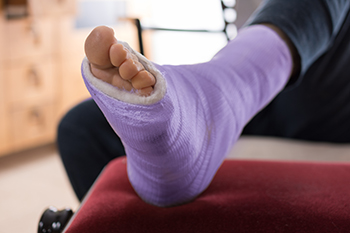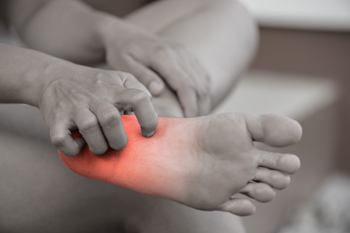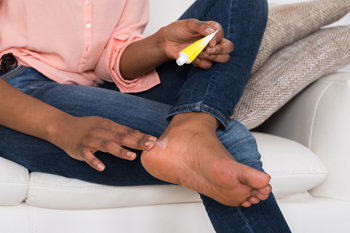Items filtered by date: October 2022
Foot Stress Fracture Symptoms

When an individual suffers a stress fracture, they essentially have developed tiny cracks in the bone, often due to repetitive or prolonged pressure. There are a number of different symptoms that are characteristic of a stress fracture. Namely, if you suffer from a stress fracture, you may develop bruising on the skin in the affected area. Typically, this might involve discoloration of some sort around the skin. The skin, for example, may appear to have a red, blue, or purple tint. Additionally, stress fractures may create poignant, localized pain at the site of the fracture. This pain can be worse when putting weight on the feet. Many individuals suffer from stress fractures—if you are one of them, consult with a podiatrist today.
Activities where too much pressure is put on the feet can cause stress fractures. To learn more, contact Barbara J. Aung, DPM from Aung Foot Health Clinic . Our doctor can provide the care you need to keep your pain free and on your feet.
Dealing with Stress Fractures of the Foot and Ankle
Stress fractures occur in the foot and ankle when muscles in these areas weaken from too much or too little use. The feet and ankles then lose support when walking or running from the impact of the ground. Since there is no protection, the bones receive the full impact of each step. Stress on the feet can cause cracks to form in the bones, thus creating stress fractures.
What Are Stress Fractures?
Stress fractures occur frequently in individuals whose daily activities cause great impact on the feet and ankles. Stress factors are most common among:
- Runners
- People affected with Osteoporosis
- Tennis or basketball players
- Gymnasts
- High impact workouts
Symptoms
Pain from the fractures occur in the area of the fractures and can be constant or intermittent. It will often cause sharp or dull pain with swelling and tenderness. Engaging in any kind of activity which involves high impact will aggravate pain.
If you have any questions please feel free to contact our office located in Tuscon, AZ . We offer the newest diagnostic and treatment technologies for all your foot and ankle needs.
How Bad Can Peripheral Neuropathy Get?

The peripheral nervous system consists of nerves that reach receptors in the skin for sensations and muscle fibers for motion. Everything starts in the spinal cord and nerves branch out until they reach their destinations. Specific parts of the brain are responsible for moving muscles or sensing pain locations. Peripheral neuropathy is a term that refers to damage to the peripheral nervous system. Different types of peripheral neuropathy create different symptoms. Sensory symptoms include numbness, pain, hot or cold sensations, needle-pricking sensations, and complete loss of sensation. Motor manifestations present themselves as muscle weakness, twitching, paralysis, tremors, and severe cramps. Diagnosing peripheral neuropathy is challenging, both in the condition created and the underlying cause. The condition and its cause are especially important if there is a lack of sensation, as this can make extremities liable to injury without care. Wounds can become infected, and limbs can be in danger. If you feel you might have peripheral neuropathy, contact a podiatrist for proper diagnosis and treatment.
Neuropathy
Neuropathy can be a potentially serious condition, especially if it is left undiagnosed. If you have any concerns that you may be experiencing nerve loss in your feet, consult with Barbara J. Aung, DPM from Aung Foot Health Clinic . Our doctor will assess your condition and provide you with quality foot and ankle treatment for neuropathy.
What Is Neuropathy?
Neuropathy is a condition that leads to damage to the nerves in the body. Peripheral neuropathy, or neuropathy that affects your peripheral nervous system, usually occurs in the feet. Neuropathy can be triggered by a number of different causes. Such causes include diabetes, infections, cancers, disorders, and toxic substances.
Symptoms of Neuropathy Include:
- Numbness
- Sensation loss
- Prickling and tingling sensations
- Throbbing, freezing, burning pains
- Muscle weakness
Those with diabetes are at serious risk due to being unable to feel an ulcer on their feet. Diabetics usually also suffer from poor blood circulation. This can lead to the wound not healing, infections occurring, and the limb may have to be amputated.
Treatment
To treat neuropathy in the foot, podiatrists will first diagnose the cause of the neuropathy. Figuring out the underlying cause of the neuropathy will allow the podiatrist to prescribe the best treatment, whether it be caused by diabetes, toxic substance exposure, infection, etc. If the nerve has not died, then it’s possible that sensation may be able to return to the foot.
Pain medication may be issued for pain. Electrical nerve stimulation can be used to stimulate nerves. If the neuropathy is caused from pressure on the nerves, then surgery may be necessary.
If you have any questions, please feel free to contact our office located in Tuscon, AZ . We offer the newest diagnostic and treatment technologies for all your foot care needs.
Arthritis Can Cause Pain in the Feet and Ankles
Signs of Cracked Heels

One of the many unsightly and unattractive conditions of the feet is known as cracked heels. Also known as heel fissures or split heel, this condition occurs when the skin on the heel becomes exceedingly dry. There are several signs of cracked heels that you can be on the lookout for. First, the most obvious sign of cracked heels is a developing callus on the heel that can be either a shade of yellow or brown. If the condition is relatively new, you might notice small cracks in the hardened skin callus. However, if this condition is older and has not been treated for a long period of time, then there may be deeper cracks in the callus. These deeper cracks might even bleed in severe cases, inviting infection. If you notice any of these signs, or you believe that you might have cracked heels, do not hesitate to schedule an appointment with a podiatrist today.
Cracked heels are unsightly and can cause further damage to your shoes and feet. If you have any concerns, contact Barbara J. Aung, DPM from Aung Foot Health Clinic . Our doctor can provide the care you need to keep you pain-free and on your feet.
Cracked Heels
Cracked heels appear unappealing and can make it harder for you walk around in sandals. Aside from looking unpleasant, cracked heels can also tear stockings, socks, and wear out your shoes. There are several methods to help restore a cracked heel and prevent further damage.
How Do You Get Them?
Dry skin is the number one culprit in creating cracked heels. Many athletes, walkers, joggers, and even swimmers suffer from cracked heels. Age and skin oil production play a role to getting cracked heels as well.
Promote Healing
Over the counter medicines can help, especially for those that need instant relief or who suffer from chronic dry feet.
Wear Socks – Wearing socks with medicated creams helps lock in moisture.
Moisturizers – Applying both day and night will help alleviate dryness which causes cracking.
Pumice Stones – These exfoliate and remove dead skin, which allows for smoother moisturizer application and better absorption into the skin.
Change in Diet
Eating healthy with a well-balanced diet will give the skin a fresh and radiant look. Your body responds to the kinds of food you ingest. Omega-3 fatty acids and zinc supplements can also revitalize skin tissue.
Most importantly, seek professional help if unsure how to proceed in treating cracked heels. A podiatrist will help you with any questions or information needed.
If you have any questions, please feel free to contact our office located in Tuscon, AZ . We offer the newest diagnostic and treatment technologies for all your foot care needs.
Puncture Wounds

When an individual steps on a small, pointy object, they may endure what is known as a puncture wound of the foot. Puncture wounds create small holes in the skin, and can be caused from stepping on nails, seashells, or pieces of glass, among other things. Injuring the foot in this way is more common during the warmer months because individuals are more likely to walk around barefoot. Puncture wounds can be problematic because the foreign object may become embedded in the skin if not properly treated. Additionally, the wound may facilitate an infection because dirt and debris can become stuck in the entry hole from the wound. In treating a puncture wound, a medical professional will ensure that the foreign body has been removed from the affected area and that the wound is properly cleaned. It is also important to remember that the depth of the puncture can indicate the likelihood of developing an infection, as deeper punctures can be more problematic. Contact a podiatrist today if you believe you have a puncture wound.
Wound care is an important part in dealing with diabetes. If you have diabetes and a foot wound or would like more information about wound care for diabetics, consult with Barbara J. Aung, DPM from Aung Foot Health Clinic . Our doctor will assess your condition and provide you with quality foot and ankle treatment.
What Is Wound Care?
Wound care is the practice of taking proper care of a wound. This can range from the smallest to the largest of wounds. While everyone can benefit from proper wound care, it is much more important for diabetics. Diabetics often suffer from poor blood circulation which causes wounds to heal much slower than they would in a non-diabetic.
What Is the Importance of Wound Care?
While it may not seem apparent with small ulcers on the foot, for diabetics, any size ulcer can become infected. Diabetics often also suffer from neuropathy, or nerve loss. This means they might not even feel when they have an ulcer on their foot. If the wound becomes severely infected, amputation may be necessary. Therefore, it is of the upmost importance to properly care for any and all foot wounds.
How to Care for Wounds
The best way to care for foot wounds is to prevent them. For diabetics, this means daily inspections of the feet for any signs of abnormalities or ulcers. It is also recommended to see a podiatrist several times a year for a foot inspection. If you do have an ulcer, run the wound under water to clear dirt from the wound; then apply antibiotic ointment to the wound and cover with a bandage. Bandages should be changed daily and keeping pressure off the wound is smart. It is advised to see a podiatrist, who can keep an eye on it.
If you have any questions, please feel free to contact our office located in Tuscon, AZ . We offer the newest diagnostic and treatment technologies for all your foot care needs.






